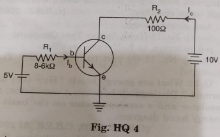A silicon transistor amplifier circuit is given below. If current amplification factor β=100, determine

Collector emitter voltage.
Take voltage drop between base and emitter as 0.7 V.Solution in Punjabi
Step by step video & image solution for A silicon transistor amplifier circuit is given below. If current amplification factor beta=100, determineCollector emitter voltage.Take voltage drop between base and emitter as 0.7 V. by Physics experts to help you in doubts & scoring excellent marks in Class 12 exams.
Updated on:21/07/2023Similar Questions
The current amplification factor α of a common base transistor and the current amplification factor βof a common emitter transistor are not related by
View SolutionFor a common emitter transistor amplifier, the audio signal voltage across the collector resistance of 2 kOmega is 2 V. Suppose the current amplification factor of the transistor is 100, the base current if base resistance is 1 k Omega is
View SolutionIn a common emitter transistor amplifier, beta=60, R_(0)=5000Omega and internal resistance of a transistor is 500Omega . The voltage amplification of the amplifier will be
View SolutionA silicon transistor amplifier circuit is given below. If current amplification factor beta=100 , determine Base current I_b . Take voltage drop between base and emitter as 0.7 V.
View SolutionA silicon transistor amplifier circuit is given below. If current amplification factor beta=100 , determine Collector current I_c . Take voltage drop between base and emitter as 0.7 V.
View SolutionA silicon transistor amplifier circuit is given below. If current amplification factor β=100, determine

Collector base voltage.
Take voltage drop between base and emitter as 0.7 V.
View SolutionIn a common emitter transistor amplifier, beta = 60,R_(0) = 5000Omega and the internal resistance of a transistor 500Omega Is. The voltage amplification of the amplifier will be:
View Solution
